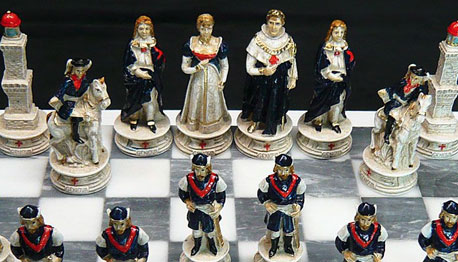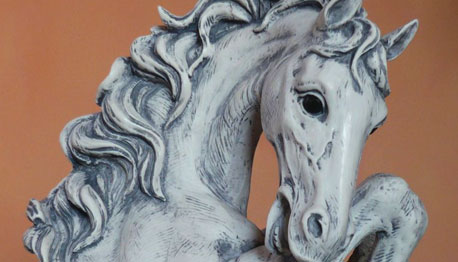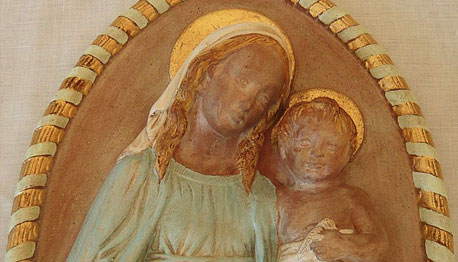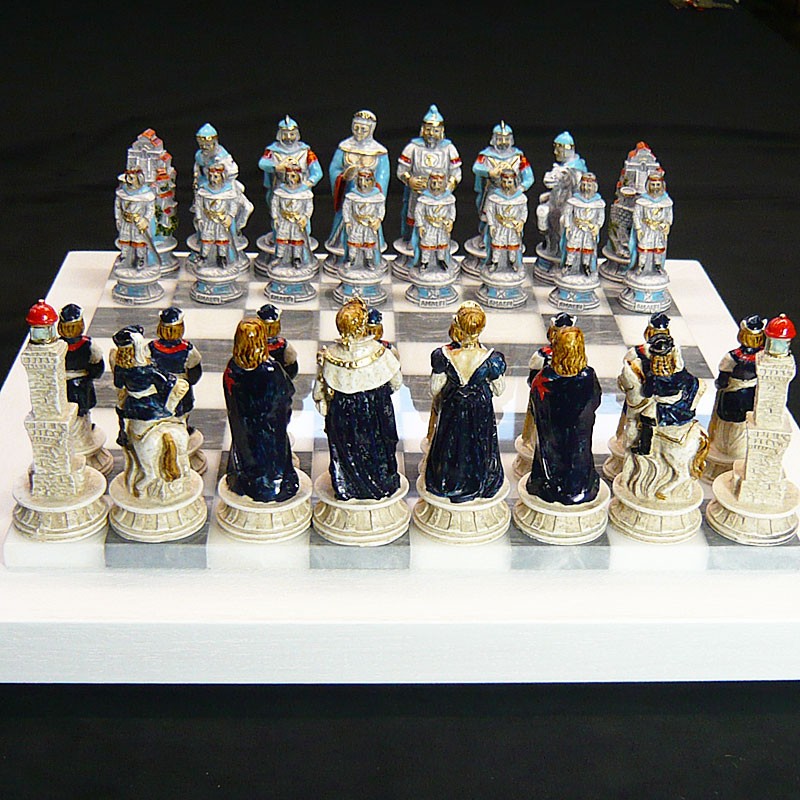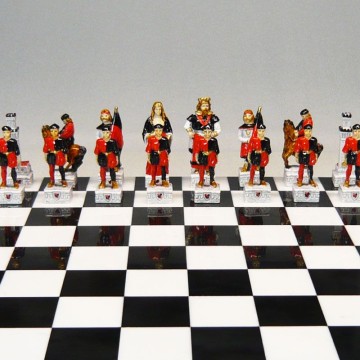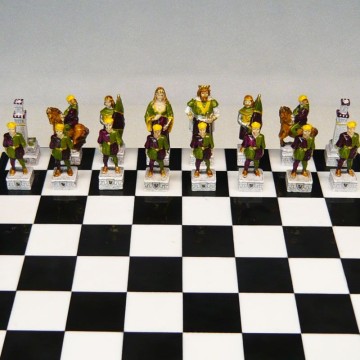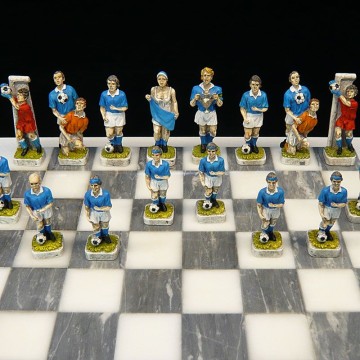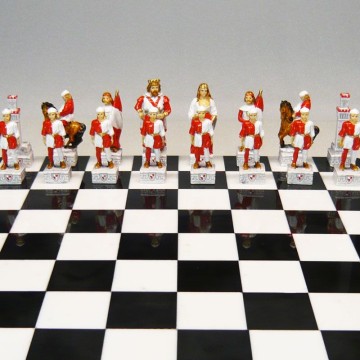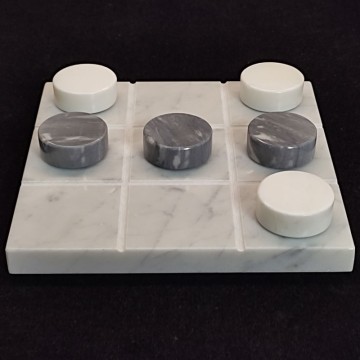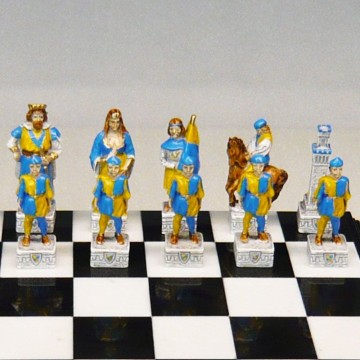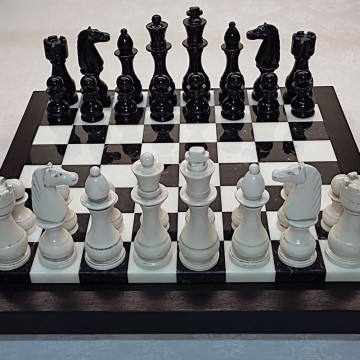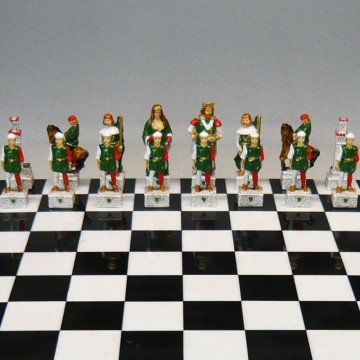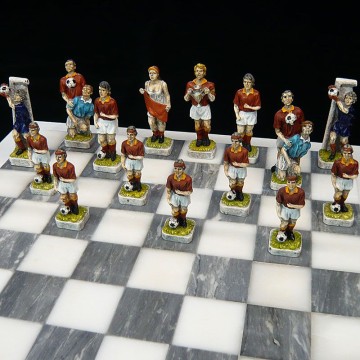Maritime Republics Chess "Genoa"
Reference: NSSCRMGe
Set of 32 pieces (16 + 16)
Artistic creation in recomposed marble, handmade and hand-painted by master craftsmen
Choose from the menu below the combination with the desired Maritime Republic
 Security policies
Security policies
Transactions on PayPal secure server
 Terms and Conditions
Terms and Conditions
Read our term and conditions
The raw material, marble dust from the quarries of Carrara, combined with the long experience of master craftsmen and highly professional designers, is what makes these artistic creations (statues, small animals, chess) unique: original and high level subjects to be proposed to fans and collectors.
The chess. Artistic creation composed by 32 pieces made with marble dust from the quarries of Carrara, aged and hand-painted with rich details by skilled masters of art.
They reproduce historical, art and fantasy figures, creating an extraordinary atmosphere that immerses players in a dense backdrop of realism.
Chess is a two-player strategy board game played on a checkered board with 64 squares arranged in an 8×8 square grid. Played by millions of people worldwide, chess is believed to be derived from the Indian game chaturanga sometime before the 7th century. Chaturanga is also the likely ancestor of the East Asian strategy games xianggi (Chinese chess), janggi (Korean chess), and shogi (Japanese chess). Chess reached Europe via Persia and Arabia by the 9th century, due to the Umayyad conquest of Hispania. The queen and bishop assumed their current powers in Spain in the late 15th century, and the modern rules were standardized in the 19th century.
Play involves no hidden information. Each player begins with 16 pieces: one king, one queen, two rooks, two knights, two bishops and eight pawns. Each piece type moves differently, with the most powerful being the queen and the least powerful the pawn. The objective is to checkmate the opponent's king by placing it under an inescapable threat of capture. To this end, a player's pieces are used to attack and capture the opponent's pieces, while supporting one another. During the game, play typically involves exchanging pieces for the opponent's similar pieces, and finding and engineering opportunities to trade advantageously or to get a better position. In addition to checkmate, a player wins the game if the opponent resigns, or in a timed game, runs out of time. There are also several ways a game can end in a draw.
The Maritime Republics (Italian: repubbliche marinare) of the Mediterranean Basin were thalassocratic city-state in Italy and Dalmatia during the Middle Ages. The best known among them were Venice, Genoa, Pisa and Amalfi.
From the 10th century, they built fleets of ships both for their own protection and to support extensive trade networks across the Mediterranean, giving them an essential role in reestablishing contacts between Europe, Asia and Africa, which had been interrupted during the early Middle Ages. These contacts were not only commercial, but also cultural and artistic. They also had an essential role in the Crusades.
The expression "Maritime Republics" refers to the Italian city-state, that since the Middle Ages enjoyed, thanks to its maritime activities, political autonomy and economic prosperity. The economic growth of Europe around the year 1000, together with the hazards of the mainland trading routes, made possible the development of major commercial routes along the Mediterranean coast. The growing independence acquired by some coastal cities gave them a leading role in this development. These cities, exposed to pirate raids (mostly Saracen), organized their own defence, providing themselves substantial war fleets. Thus, in the 10th and 11th centuries they were able to switch to an offensive stance, taking advantage of the rivalry between the Byzantine and Islamic maritime powers and competing with them for the control of commerce and trade routes with Asia and Africa.
Venice, Genoa and Pisa had dominion over different overseas lands, including many Mediterranean islands (especially Sardinia and Corsica), lands on the Adriatic, Aegean, and Black Sea (Crimea), and commercial colonies in the Near East and in North Africa. Venice stands out from the rest in that it maintained enormous tracts of land in Greece, Cyprus, Istria and Dalmatia until as late as the mid-17th century.
Genoa, also known as La Superba ("the Superb one"), began to gain autonomy from the Holy Roman Empire around the 11th century, becoming a city-state with a republican constitution, and participating in the First Crusades. Initially called Compagna Communis, the denomination of republic was made official in 1528 on the initiative of Admiral Andrea Doria.
The alliance with Pisa allowed the liberation of the western sector of the Mediterranean from Saracen pirates, with the reconquest of Corsica, the Balearics and Provence.
The fortunes of the town increased considerably when it joined the First Crusade: its participation brought great privileges for the Genoese colonists, which moved to many places in the Holy Land. The apex of Genoese fortune came in the 13th century with the conclusion of the Treaty of Nymphaeum (1261) with the Byzantine emperor Michael VIII Palaeologus. In exchange for aiding the Byzantine reconquest of Constantinople, this led to the ousting of the Venetians from the straits leading to the Black Sea, which quickly became a Genoese sea. Shortly afterwards, in 1284, Pisa was finally defeated in the Battle of Meloria by the Genoese Navy.
In 1298 the Genoese defeated the Venetian fleet at the Dalmatian island of Curzola. The confrontation led to the capture of the Venetian Admiral and Marco Polo, who during his imprisonment at the Palazzo San Giorgio dictated the story of his travels to Rustichello da Pisa, his cellmate. Genoa remained relatively powerful until the last major conflict with Venice, the War of Chioggia of 1379. It ended in victory for the Venetians, who finally regained dominance over trade to the East.
After a gloomy 15th century marked by plagues and foreign domination, the city regained self-government in 1528 through the efforts of Andrea Doria, who created a new constitution for Genoa. Throughout the following century Genoa became the primary sponsor of the Spanish monarchy, reaping huge profits, which allowed the old patrician class to remain vital for a period. The Republic remained independent until 1797, when it was conquered by the French First Republic under Napoleon and replaced with the Ligurian Republic. After a brief revival in 1814, the Republic was ultimately annexed by the Kingdom of Sardinia in 1815.
Data sheet
- Code
- NSSCRMGe
- Size
- h. cm. 7,5 ~ 9,5 (every chess is made unique by little irregularities of shape and colour)





